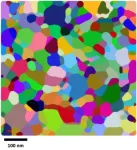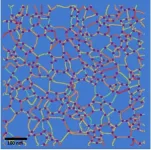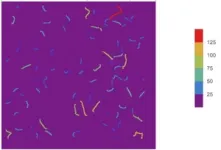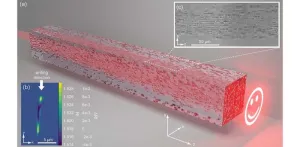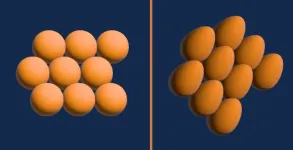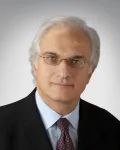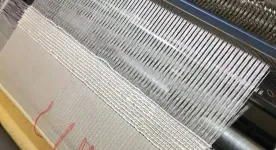(Press-News.org) The orientations of these infinitesimally small separations between individual “grains” of a polycrystalline material have big effects. In a material such as aluminum, these collections of grains (called microstructures) determine properties such as hardness.
New research is helping scientists better understand how microstructures change, or undergo “grain growth,” at high temperatures.
A team of materials scientists and applied mathematicians developed a mathematical model that more accurately describes such microstructures by integrating data that can be identified from highly magnified images taken during experiments. Their findings are published in Nature: Computational Materials.
The research team included Jeffrey M. Rickman, Class of '61 Professor of Materials Science & Engineering at Lehigh University; Katayun Barmak, Philips Electronics Professor of Applied Physics and Applied Mathematics at Columbia University; Yekaterina Epshteyn, Professor of Mathematics at the University of Utah; and Chun Liu, Professor of Applied Mathematics at the Illinois Institute of Technology.
“Our model is novel because it is given in terms of features that can be identified from experimental micrographs, or photos that reveal the details of microstructures at a length scale of nanometers to microns,” Rickman said. “Because our model can be related to these experimental features, it is a more faithful representation of the actual grain growth process.”
The researchers conducted crystal orientation mapping on thin films of aluminum with columnar grains and used a stochastic, marked point process to represent triple junctions, points where three grains and grain boundaries meet in the structure. Their model is the first to integrate data on the interactions and disorientations of these triple junctions to predict grain growth.
Predicting grain growth is key to the creation of new materials and is a pivotal area of study in materials science. As a result, many models of grain growth have been developed. However, the project’s direct link between the mathematical model and the experimental micrographs is highly distinctive.
According to Rickman, linking the model directly to features that can be tracked during experiments will benefit computational materials scientists who model the kinetics of grain growth.
“Ultimately, this research provides a way to better understand how grain growth works and how it can be used to inform the development of new materials,” Rickman said.
The research was funded by the National Science Foundation under the prestigious Designing Materials to Revolutionize and Engineer Our Future (DMREF) program. Rickman is lead author of the research article, “Point process microstructural model of metallic thin films with implications for coarsening,” with Barmak, Epshteyn and Liu as co-authors.
END
Want to make better materials? Read between the lines. Or the “grain boundaries,” as they’re known in materials science.
New research is helping scientists better understand how microstructures change, or undergo “grain growth,” at high temperatures.
2023-04-21
ELSE PRESS RELEASES FROM THIS DATE:
New injectable cell therapy developed by WFIRM scientists could resolve osteoarthritis
2023-04-21
WINSTON-SALEM, NC, April 21, 2023 – Wake Forest Institute for Regenerative Medicine (WFIRM) scientists have created a promising injectable cell therapy to treat osteoarthritis that both reduces inflammation and also regenerates articular cartilage.
Recently identified by the Food and Drug Administration as a public health crisis, osteoarthritis affects more than 520 million people worldwide who deal with pain and inflammation. Osteoarthritis is typically induced by mechanical or traumatic stress in the joint, leading to damaged cartilage that cannot be repaired naturally.
“Without better understanding of what drives the initiation and progression of osteoarthritis, effective treatment ...
New approach to developing efficient, high-precision 3D light shapers
2023-04-21
Modern-day technologies like optical computing, integrated photonics, and digital holography require light signals to be manipulated in three dimensions. To achieve this, it is necessary to be able to shape and guide the flow of light according to its desired application. Given that light flow within a medium is governed by the refractive index, specific tailoring of the refractive index is needed to realize control of the light path within the medium.
To this end, scientists have developed what are called “aperiodic photonic ...
New McCombs Award honors Herb Miller
2023-04-21
New McCombs Award Honors Herb Miller
Professional Faculty Impact Award recognizes exceptional contributions of teaching, service, and mentorship.
Associate Professor of Instruction Herb Miller is the namesake and the first recipient of the new McCombs School of Business Marketing Department Herbert A. Miller Jr. Professional Faculty Impact Award.
The award was made possible by William Cunningham, who served as McCombs dean, UT Austin president, and University of Texas System chancellor, as a way to recognize and honor the professional faculty in the department of marketing.
“In ...
Putting hydrogen on solid ground: Simulations with a machine learning model predict a new phase of solid hydrogen
2023-04-21
Hydrogen, the most abundant element in the universe, is found everywhere from the dust filling most of outer space to the cores of stars to many substances here on Earth. This would be reason enough to study hydrogen, but its individual atoms are also the simplest of any element with just one proton and one electron. For David Ceperley, a professor of physics at the University of Illinois Urbana-Champaign, this makes hydrogen the natural starting point for formulating and testing theories of matter.
Ceperley, also a member of the Illinois Quantum ...
Researchers develop safety monitoring system for construction sites
2023-04-21
University of Houston computer scientists have developed a new system to keep construction workers safe at job sites. Their findings and process are laid out in a study published in the research journal Applied Sciences.
According to the Occupational Safety and Health Administration, 4,764 workers died on the job in 2020. Employees in construction and extraction occupations accounted for 20% of those deaths. Many were struck by a vehicle or mobile machinery on construction sites. Although the construction industry has enlisted the help of safety experts, a great number of fatalities and injuries still occur.
“The point of our research project was to enhance safety of workers ...
Study finds alcohol-related liver disease soared in nearly all states during the pandemic, with one race particularly affected
2023-04-21
BOSTON – Alcohol consumption increased substantially across the United States during the COVID-19 pandemic, but the impact was greatest among American Indian and Alaska Native (AIAN) populations, where deaths from alcohol-associated liver disease were six times those of white people, according to a study by Massachusetts General Hospital (MGH), a founding member of Mass General Brigham (MGB). The disproportionately high mortality rate reflects not just the pandemic, but a systemic failure of supportive health care and lack of critical resources for AIAN populations ...
World’s largest grammar database reveals accelerating loss of language diversity
2023-04-21
There’s a crisis unfolding in the field of linguistics: Global language experts estimate that, without intervention, about one language will be lost every month for the next 40 years.
A study published in Science Advances debuts a grammatical database that documents the enormous diversity of current languages on the planet, highlighting just how much humanity stands to lose and why it's worth saving.
Known as Grambank, it is now the world’s largest publicly available comparative grammatical database. Initiated by scholars in the Department of Linguistic and Cultural Evolution at the ...
Study points to new approach to treat chronic transplant rejection
2023-04-21
University of Pittsburgh researchers have identified a type of immune cell that drives chronic organ transplant failure in a mouse model of kidney transplantation and uncovered pathways that could be therapeutically targeted to improve patient outcomes. The findings are published in a new Science Immunology paper.
“In solid organ transplantation, such as kidney transplants, one-year outcomes are excellent because we have immunosuppressant drugs that manage the problem of acute rejection,” ...
Cheaper method for making woven displays and smart fabrics – of any size or shape
2023-04-21
Researchers have developed next-generation smart textiles – incorporating LEDs, sensors, energy harvesting, and storage – that can be produced inexpensively, in any shape or size, using the same machines used to make the clothing we wear every day.
The international team, led by the University of Cambridge, have previously demonstrated that woven displays can be made at large sizes, but these earlier examples were made using specialised manual laboratory equipment. Other smart textiles can be manufactured in specialised microelectronic fabrication facilities, but these are highly expensive and produce large volumes of waste.
However, the team found that flexible ...
Researchers devise cascaded microfluidic circuits for pulsatile filtration of extracellular vesicles directly from whole blood samples
2023-04-21
Extracellular vesicles (EVs) are cell-secreted lipid bilayer bioparticles with a diameter of 30 to 250 nm. They are a promising source of biomarkers for liquid biopsies for early cancer diagnosis and real-time monitoring of tumor development. However, analysis of nanosized EVs in blood samples has been hampered by the lack of effective, rapid, and standardized methods to isolate and purify EVs.
In a study published in Science Advances, SUN Jiashu’s group from the National Center for Nanoscience and Technology (NCNST) of the Chinese Academy of Sciences (CAS) and collaborators from the Fifth Medical Center of the Chinese PLA General ...
LAST 30 PRESS RELEASES:
Review article | Towards a Global Ground-Based Earth Observatory (GGBEO): Leveraging existing systems and networks
Penn and UMich create world’s smallest programmable, autonomous robots
Cleveland researchers launch first major study to address ‘hidden performance killer’ in athletes
To connect across politics, try saying what you oppose
Modulating key interaction prevents virus from entering cells
Project explores barriers to NHS career progression facing international medical graduates
Jeonbuk National University researchers explore the impact of different seasonings on the flavor perception of Doenjang soup
Two Keck Medicine of USC Hospitals named Leapfrog Top Teaching Hospitals
World-first discovery uncovers how glioblastoma tumours dodge chemotherapy, potentially opening the door to new treatments
A fatal mix-up: How certain gut bacteria drive multiple sclerosis
New AI tool identifies not just genetic mutations, but the diseases they may cause
Deep-learning model predicts how fruit flies form, cell by cell
Combination pills for high blood pressure may simplify treatment, improve long-term health
Immune system keeps mucosal fungi in check
Neurons within the brain use simple rules to localize genetic messages
Electrodes created using light
Second-hand gift-giving is a well-deliberated decision
How human interaction drove evolution to make bears less aggressive
National Poll: Few parents offer teens guidance on healthy eating during holiday season
Cannabis derivatives could provide new ovarian cancer treatments
Raising strong yeast as a petroleum substitute
Clues to the origin of hot Jupiters hidden in their orbits
Canada’s reduced pledge to Global Fund will impact domestic health
1 in 4 children with major traumatic injuries not cared for in pediatric trauma centres
Duke and Duke-NUS’ joint cross-population research to uncover "East-West" differences in disease and care
Scientists to ‘spy’ on cancer- immune cell interactions using quantum technology breakthrough
Tech savvy users have most digital concerns
Making lighter work of calculating fluid and heat flow
Normalizing blood sugar can halve heart attack risk
Lowering blood sugar cuts heart attack risk in people with prediabetes
[Press-News.org] Want to make better materials? Read between the lines. Or the “grain boundaries,” as they’re known in materials science.New research is helping scientists better understand how microstructures change, or undergo “grain growth,” at high temperatures.
